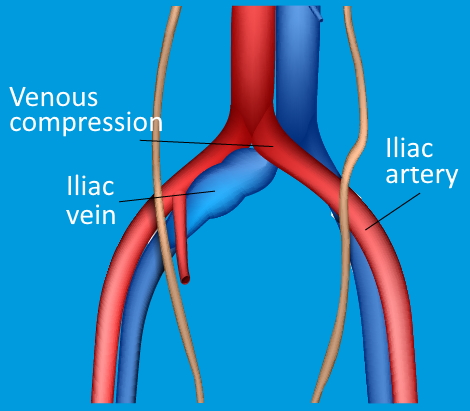Iliac Vein Compression
ILIAC VEIN COMPRESSION SYNDROME Q & A
Iliac vein compression syndrome (IVCS) is a serious condition that affects two major blood vessels in the legs. Also known as May-Thurner syndrome or Crockett’s syndrome, IVCS can affect up to 25% of adults, and potentially more with a deep vein thrombosis (DVT).
What Is Iliac Vein Compression Syndrome?
Blood travels through the body via a network of blood vessels. Arteries move blood away from the heart, and veins bring it back. The iliac vein and artery run down the legs. In some people, these blood vessels cross over in the pelvic region. Generally, this is only a problem if iliac vein compression syndrome is present. In iliac vein compression syndrome (IVCS), the right iliac artery puts pressure on the left iliac vein, preventing blood flowing back from the left leg to the heart. This can lead to a deep vein thrombosis (DVT).


Frequently Asked Questions
Iliac Vein Compression Syndrome Patient Education
What Causes Iliac Vein Compression Syndrome?
People of all ages and genders are affected by IVCS. Its occurrence can appear random. Most people are not affected by crossing iliac blood vessels. However, their specific position and placement in each individual can predicate the risk of IVCS. Other risk factors include:
- Being female
- Scoliosis
- Recent childbirth
- Giving birth more than once
- Oral contraceptives
- Dehydration
- Medical condition causing blood to clot
What Are Iliac Vein Compression Syndrome Symptoms?
IVCS does not cause symptoms, so most people are unaware if they have it. Generally, it becomes apparent when the patient develops a DVT. If someone is experiencing pain and swelling in the left leg, it is possible that IVCS has progressed to a DVT.
How Is Iliac Vein Compression Syndrome Diagnosed?
To diagnose IVCS, doctors review a patient’s medical history and perform a complete physical exam. In addition, diagnostic imaging will give a closer look at the blood vessels, to see if the iliac artery is pushing against the iliac vein, and blood flow from the left leg is compromised.
Do Patients Need ICVS Treatment?
Yes. If IVCS has caused a DVT in the left leg, there can be serious consequences without treatment. Firstly, a DVT can be very painful and lead to mobility issues. Secondly, damage to the veins and valves in the leg from a DVT can cause blood clots. Lastly, a blood clot can be life threatening if it breaks off and travels to the lungs, causing a pulmonary embolism.
How Is Iliac Vein Compression Syndrome Treated?
Iliac vein stenting, a type of angioplasty, is a minimally invasive treatment for IVCS.
Specialized Patient Care
If you have circulation problems affecting your left leg more than your right leg or are concerned about symptoms of a DVT, Dr. Jilbert Eradat can help. With expertise in treating iliac vein compression syndrome, Dr. Eradat gives each patient individualized attention. Major insurance plans and Medicare accepted.


631 West Avenue Q, Suite A
Palmdale, CA 93551
Phone 661-480-5956
Fax 661-480-5976
Hours
- Monday–Friday
8 am – 5pm
Resources
Connect

